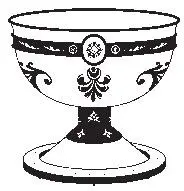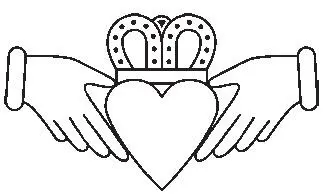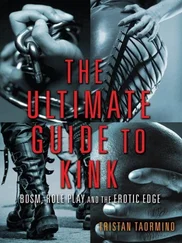Existing symbols—such as a heart, or birds and animals—are often rendered in Celtic knotwork. In this case, the form of the underlying shape carries the symbolic meaning.
The Celtic Knot that is square in form is a protective symbol, called a shield knot.
In Haiti, there are certain seed pods called cha cha that are used to make rattles for ceremonial musicmaking in Voudon rituals. The rattle is called a cha cha, too, and the dance of the same name also comes from the name of the seedpod.
See also Asson.
This is a cup or grail that is generally used in rituals. No matter what the religious or spiritual persuasion of the celebrant, a chalice of some

form is used, whether it be the highly ornamented vessel of the Catholic Church or the simpler wooden cup favored by some pagan groups. The chalice itself is symbolic of water or of the Spirit, and is used as such in the suit of Cups in the Tarot, for example. The chalice is also a universal symbol of the feminine aspect because of its shape, its use as a vessel, and its link with water.
Eastern religions use a kind of bell, called a Drilbu, in the place of a chalice.
The Chaos Wheel, or Chaos Star, is a wheel constructed from eight arrow-headed spokes. Representing the notion of infinite possibilities, the symbol is a recent addition to a veritable galaxy of meaningful shapes. Designed by science fiction writer Michael Moorcock, it has been adopted as an emblem by exponents of Chaos Magic, the contemporary branch of magic inspired by the works of Austin Osman Spare.
Chess originated in India. The checkerboard that chess is played on is, in itself, a secret symbol. It is symbolic of the world that we understand, that is composed of opposing forces. Also, the black and white colors of the symmetrically arranged squares stand for male/female, light/dark, positive/negative, good/evil in much the same way as the yin-yang sign does. It is no accident that the floor of the Freemason temple has the same construction as the chessboard, a constant reminder of both the harmony and tension between opposites. The pieces, too, are black and white, reinforcing this idea.
The chessboard has a further mystery that can be revealed in the number of the squares. Each side has eight squares. Eight is the number of infinity and of completion, and eight times eight makes 64, the number of cosmic unity. This is the magical number that, in sacred geometry, is the basis of temple construction.
The square shape of the board symbolizes the stability of the Earth and its four corners, the directions and the elements.
Superficially, chess might seem to be a relatively straightforward game, a simple series of different moves ascribed to each of the pieces. However, its complexities are only really revealed when the player is so familiar with the rules that he or she can carry them out automatically. Chess is plainly connected to war strategy and the ability to surprise the opponent. A good player will understand the need to sacrifice pieces in order to gain a greater advantage. Although the pawn may appear to be valueless, it is arguably one of the most important pieces on the board, and certainly the most prolific. We even use the word “pawn” to describe a person that we think is insignificant.
In Ingmar Bergman’s film The Seventh Seal , the knight, Antonius Block, invites the hooded figure of Death to join him in a game, despite the fact that Death warns him that he cannot win. Effectively, chess owes as much to chance as choice, and further underlines the dilemma between the concepts of fate versus free will. The knight knows that he will die, yet he persists in playing the game. Stanley Kubrick, too, believed that his skill as a chess player gave him the discipline to think rationally and to see the bigger picture, an invaluable skill for a film director. The detachment and lack of emotion required by the talented player is synonymous, for many, with an idealized, Zen approach to life.
For the Celts, the game of chess was called “intelligence of the wood.” It was the game of kings and the stakes were high. The game therefore symbolizes the intellect of the king, despite the fact that the most versatile piece on the board is the queen.
See Labarum.
The Chnoubis is a hybrid creature, with the head of a lion and the tail of a serpent. It was carved onto
stones for use as an amulet, providing protection against poisons in particular. Amulets featuring the Chnoubis date back to the first century and it is supposed that this odd-looking creature may be related to Abraxas, whose image was used in a similar way.
A symbol of Reiki healers, the Choku Rei is comprised of a spiral that culminates in a hooked stick. It looks a little like the treble clef used in musical notation. The symbol is used by Reiki healers to increase the power available to them, and to help focus this energy. The meaning of Choku Rei is “place the power of the Universe here.” Healers draw the sign mentally in the air as a form of meditation, generally before and after giving a treatment.
A cicatrix is a scar, but not just any scar. It refers to a very specific incision that is scored onto the body and carries secret symbols pertaining to the person’s religious or magical beliefs. A very painful process called scarification leaves these raised marks on the skin. Until the end of the nineteenth century, Maori men had ritual scarring all over their faces in order that they might look more frightening to the enemy. A cicatrix acts as a permanent amulet that is an inherent part of the person. Its purpose is similar to that of the tattoo; the pain involved in the process is an important rite of passage. Ritual scarring is popular among dark-skinned people because a tattoo is not particularly visible against the skin.
In Italian, this means the “sprig of rue.” It is an amulet, made of silver in honor of female energy in the form of the Goddess, comprising a
model of a sprig of rue with various charms in its three branches. The Cimaruta is a very old charm, which evolved from an Etruscan magical amulet. It dates back as far as 4500 BC, although there are more contemporary versions such as the stylized one illustrated here. The charms featured generally include a crescent Moon, a key, stars, daggers, and flowers; different regions of Italy produced their own specific symbols. Also known as the Witch Charm, the Cimaruta is favored by witches, and to see one in someone’s home might indicate the spiritual persuasion of the owner. It is worn either as a pendant or might be hung over a doorway, a possible reason for the Cimaruta being double-sided. When used in this way as an ornament the Cimaruta is usually quite large in size.
The three silver branches of the Cimaruta relate to the notion of the Triple Goddess. The charm itself takes on all the significance of the rue plant as being both protective and a tool of witches, used to cast spells and throw hexes.
See First signs: Circle.

The Claddagh is a popular symbol, often incorporated into the design of rings, and worn by people as an attractive piece of ornamentation although they may not know what it symbolizes.
Читать дальше














